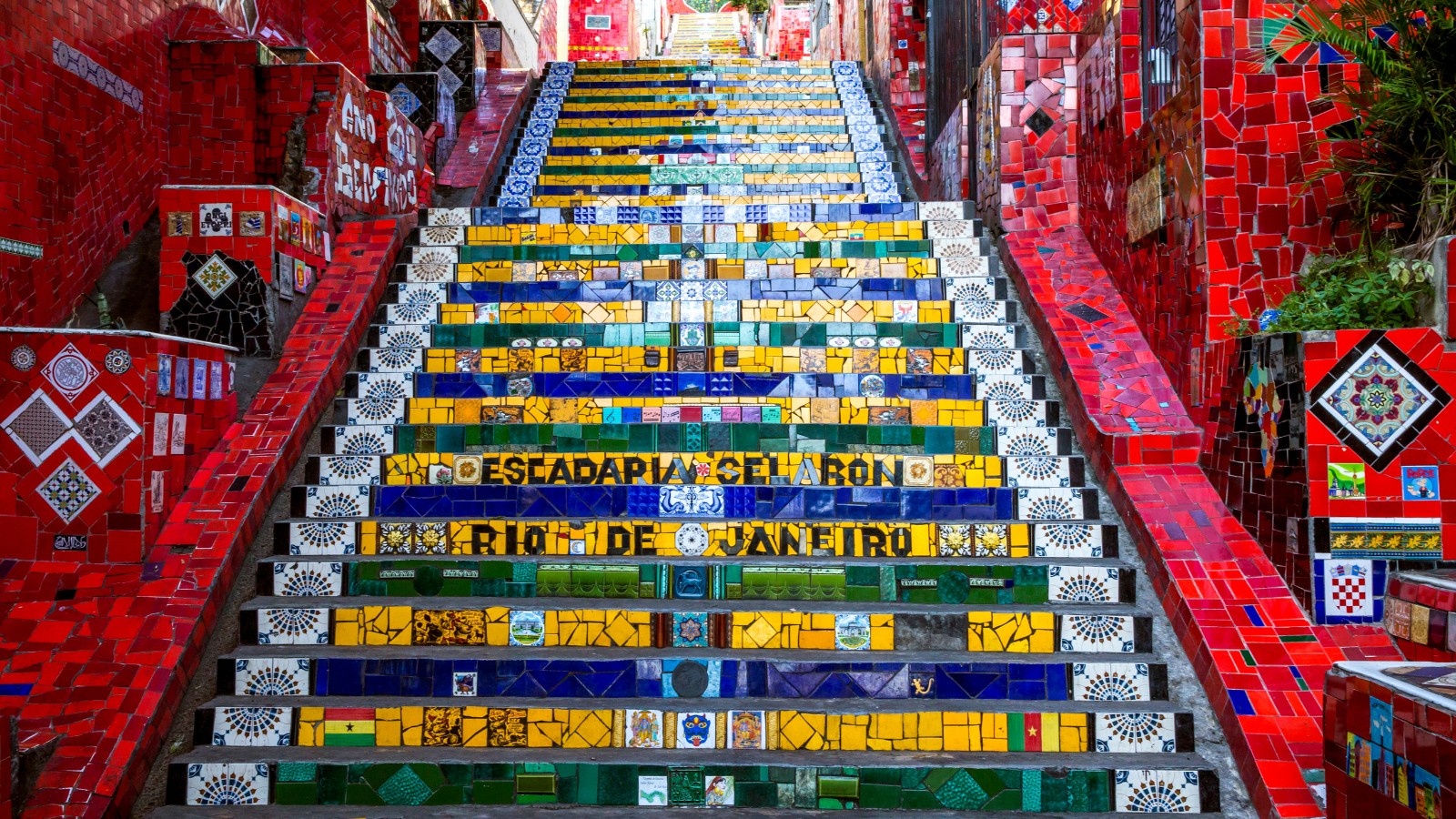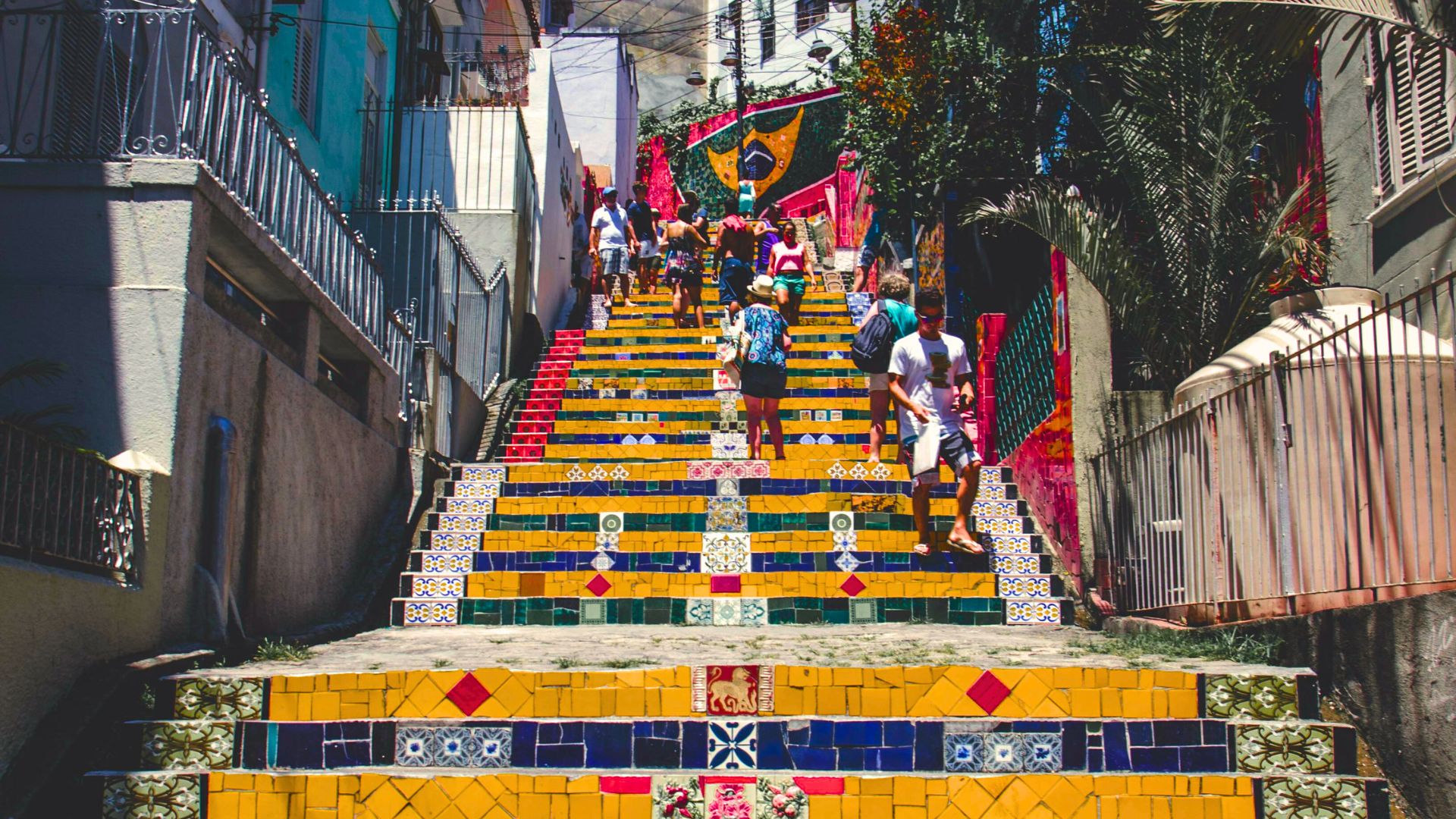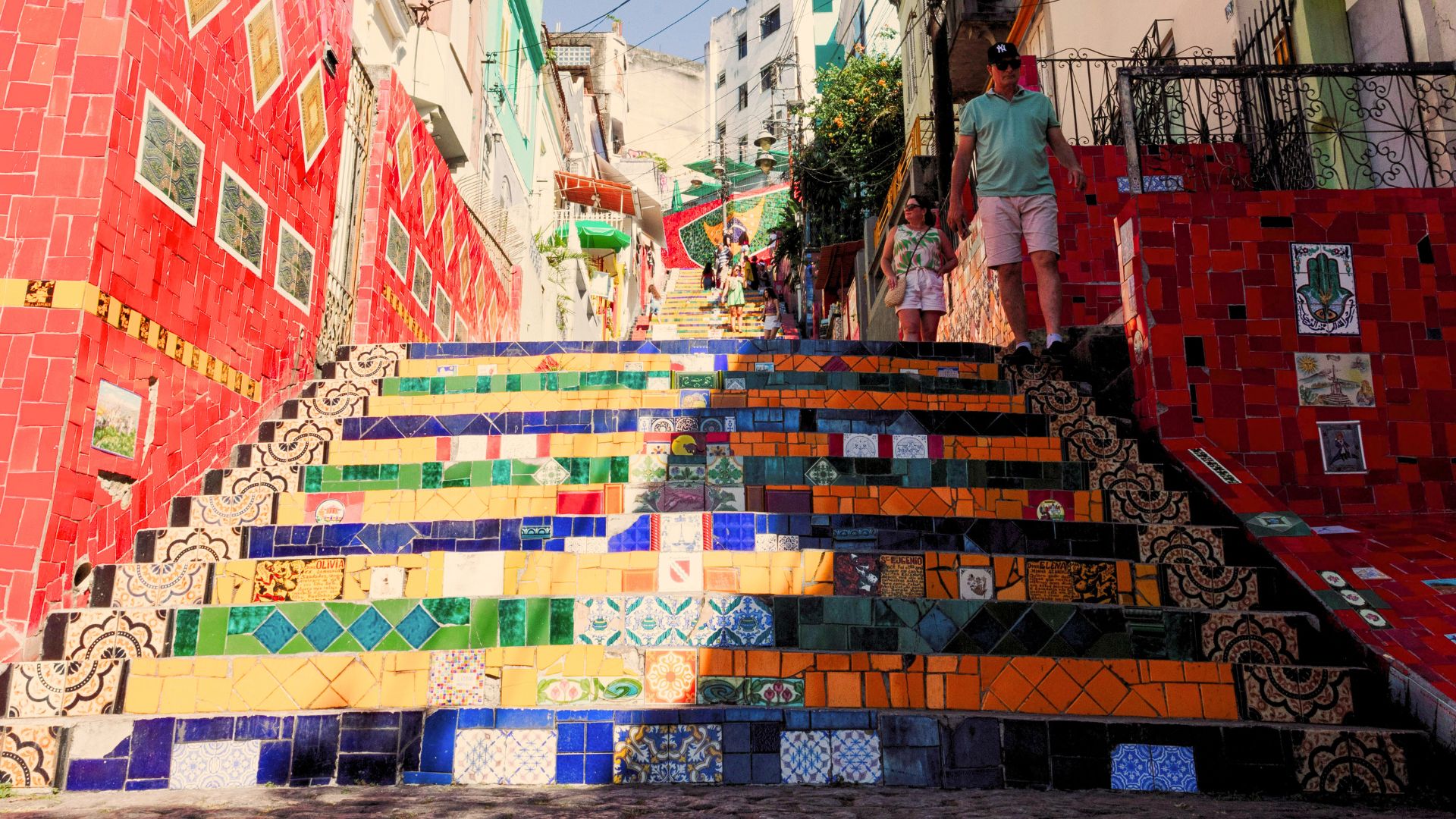
A masterpiece of colorful tiles and artistic passion, Escadaria Selarón is one of Rio de Janeiro’s most iconic landmarks, drawing visitors from around the world.
Highlights
- Admire the breathtaking mosaic staircase featuring over 2,000 tiles from more than 60 countries.
- Discover the artistic legacy of Jorge Selarón, whose hand-painted tiles make this landmark a living artwork.
- Climb to the top for a scenic view of the charming Santa Teresa neighborhood.
Tickets & Prices
Escadaria Selarón is a public landmark with free access at all times, allowing visitors to explore its lively tile patterns without any entry fees. As an open-air staircase, there are no ticketed areas, making it an easily accessible attraction for all.

What to See and Do
From its vibrant tiles to its rich artistic legacy, Escadaria Selarón is more than just a staircase—it’s an experience. Every step tells a story, whether through the intricate mosaics, the ever-evolving artwork, or the international contributions that make this landmark truly unique.
Admire the Mosaic Artwork
The first thing you’ll notice is the explosion of color covering every inch of the staircase. With over 2,000 tiles from more than 60 countries, Escadaria Selarón is a living, breathing masterpiece that continues to evolve.
Created by Chilean-born artist Jorge Selarón, the steps started as a small personal project and grew into one of Rio’s most beloved landmarks.
Selarón was known for his obsession with red tiles, and if you look closely, you’ll see that many of them feature a mysterious pregnant woman—a recurring theme in his work.
No one knows exactly who she was, and Selarón himself remained cryptic about her identity, only adding to the staircase’s intrigue. Every step tells a different story, making each visit a unique experience.
Take Iconic Photos
Escadaria Selarón is one of the most photographed places in Rio, and for good reason. The vibrant mosaics provide a stunning backdrop for travelers looking to capture the essence of the city. Whether you’re posing against the colorful tiles or capturing candid moments, every shot here feels special.
For the best shots:
- Morning light brings out the vivid colors while keeping the crowds minimal.
- The Brazilian flag tile arrangement is a must-snap location.
- The top of the staircase offers a unique angle, with the red-tiled section creating a striking contrast against the surrounding neighborhood.
Spot Unique Tiles from Around the World
One of the most fascinating aspects of Escadaria Selarón is its global collaboration. Many of the tiles were donated by visitors, meaning you might spot a piece of home while exploring the steps. Look out for tiles featuring famous landmarks, cultural symbols, and even handwritten messages left by travelers.
Some of the most interesting tiles include ones showcasing Paris’ Eiffel Tower, the Sydney Opera House, and Japanese calligraphy. It’s like a little scavenger hunt in the middle of Rio, offering surprises with every step. Take your time to explore—you never know what hidden gems you’ll find.
Climb to the Top for a View of Santa Teresa
With 215 steps, Escadaria Selarón connects the lively Lapa district with the charming Santa Teresa neighborhood. The climb is worth every step, as it rewards you with a glimpse of Santa Teresa’s historic streets, colonial mansions, and bohemian cafes.
For an even better experience, grab a coffee or a freshly made pastel (a delicious fried pastry) from one of the local vendors near the top. Sitting down with a snack and watching the world go by is the perfect way to soak in the artistic energy of the area after exploring one of Rio’s most colorful landmarks.

Directions
Escadaria Selarón is easily accessible from various points in Rio de Janeiro. The nearest metro station is Cinelândia (Line 1 – Orange and Line 2 – Green), from where it’s about a 10-minute walk to the staircase. If traveling by bus, several routes stop near Rua Joaquim Silva in Lapa, making it a convenient option for visitors staying in different parts of the city.
For those using taxis or rideshare services, simply ask for Escadaria Selarón, Rua Joaquim Silva, Lapa, and most drivers will know the location. If you’re already in the Santa Teresa neighborhood, you can reach the top of the staircase by walking downhill, offering a scenic approach with views of Rio’s historic streets.
Nearby Places
Lapa Arches (Arcos da Lapa): A historic aqueduct turned viaduct, the Lapa Arches are one of Rio’s most recognizable landmarks. At night, the area comes alive with street performers, music, and energetic nightlife.
Santa Teresa Neighborhood: Known for its bohemian atmosphere, Santa Teresa is filled with colonial mansions, art studios, and charming cafes. The neighborhood offers a mix of culture, history, and stunning city views.
Metropolitan Cathedral of Rio de Janeiro: This striking modernist cathedral stands out with its towering conical shape. Inside, visitors can admire massive stained-glass windows that illuminate the vast interior with colorful light.
Museu da Chácara do Céu: A hidden gem in Santa Teresa, this museum showcases an impressive collection of Brazilian and European art. The museum’s hilltop location also offers breathtaking panoramic views of Rio.
Carioca Aqueduct: Also known as the Lapa Arches, this historic structure was originally built to transport water to the city. Today, it serves as a vital part of the Santa Teresa tramway, offering a scenic ride over the bustling streets of Lapa.
Did you know that: (5 Interesting Facts!)
- The tiles on Escadaria Selarón come from over 60 countries, making it a global artistic collaboration.
- Jorge Selarón, the artist behind the staircase, called it his “tribute to the Brazilian people” and continued adding to it until his passing.
- Many tiles feature a mysterious pregnant woman, a recurring theme in Selarón’s work, though he never revealed her identity.
- The staircase was originally painted in plain colors until Selarón started covering it with tiles he collected from flea markets, donations, and personal designs.

History
- 1990 – Jorge Selarón begins renovating the steps in front of his house as a personal artistic project.
- Mid-1990s – The staircase gains recognition as tourists and locals contribute tiles from around the world.
- 2000s – Escadaria Selarón becomes a widely known landmark, attracting international attention and media coverage.
- 2013 – Selarón is found deceased on the very steps he dedicated his life to, leaving behind a lasting artistic legacy.
- 2010s-Present – The staircase remains a major tourist attraction in Rio de Janeiro, continuing to evolve as visitors donate new tiles. Authorities work to preserve Selarón’s vision while ensuring its longevity for future generations.
FAQ
Is there an entrance fee to visit Escadaria Selarón?
No, Escadaria Selarón is completely free to visit, making it one of Rio’s most accessible and beloved landmarks. You can explore the staircase at any time without worrying about tickets.
How many steps are there in Escadaria Selarón?
The staircase features 215 colorful steps, connecting the Lapa district to the bohemian Santa Teresa neighborhood. Get ready for a bit of a climb, but the views and vibrant tiles make it well worth the effort!
What is the best time to visit?
For the best experience, visit early in the morning to enjoy the staircase with fewer crowds and take stunning photos in soft natural light. Late afternoon is also a great time to capture the warm glow of the sun on the tiles.
Who created Escadaria Selarón?
The staircase was the lifelong work of Jorge Selarón, a Chilean-born artist who dedicated years to transforming the steps into a public masterpiece. His signature red tiles and mysterious artwork continue to intrigue visitors today.
Can I donate a tile to be placed on the staircase?
While travelers once contributed tiles, the staircase is now largely preserved as it is. However, you can still appreciate the countless international tiles that have made their way into this ever-evolving work of art.